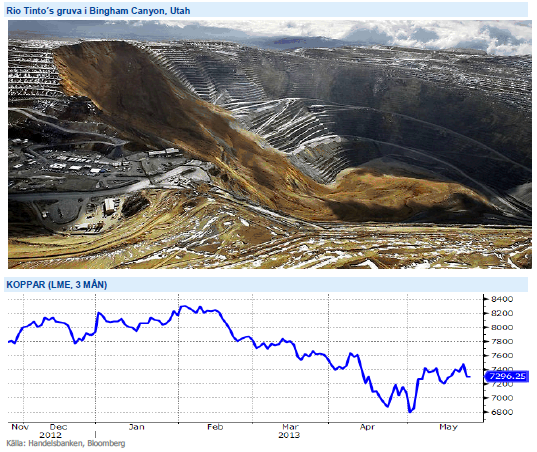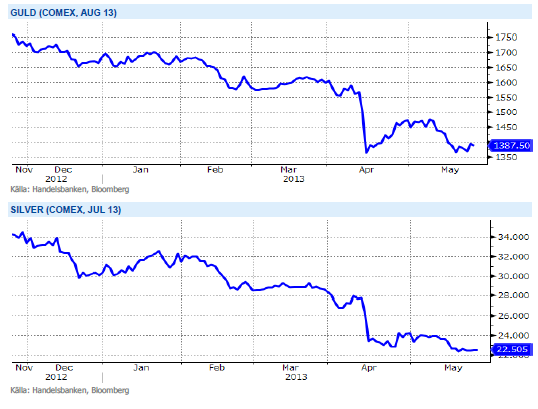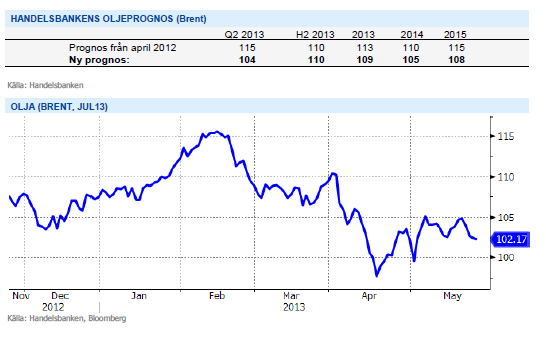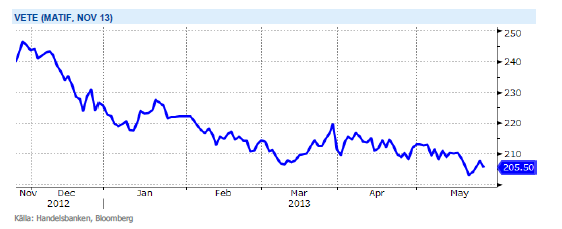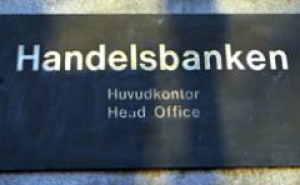Analys
SHB Råvarubrevet 24 maj 2013
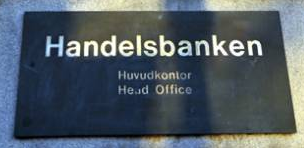
 Den senaste tiden har vi haft en negativ syn på makroutvecklingen. Makrostatistiken har överlag stött denna syn, som dock inte reflekterats i marknaderna. Visst finns det ljusglimtar, speciellt på hushållssidan i USA där konsumentförtroendet stigit kraftigt. Inköpschefsindex i Kina har dock fortsatt att falla, denna vecka det preliminära från HSBC, och trots viss återhämtning i Eurozonens inköpschefsindex tyder dessa på fortsatt recession.
Den senaste tiden har vi haft en negativ syn på makroutvecklingen. Makrostatistiken har överlag stött denna syn, som dock inte reflekterats i marknaderna. Visst finns det ljusglimtar, speciellt på hushållssidan i USA där konsumentförtroendet stigit kraftigt. Inköpschefsindex i Kina har dock fortsatt att falla, denna vecka det preliminära från HSBC, och trots viss återhämtning i Eurozonens inköpschefsindex tyder dessa på fortsatt recession.
Det var länge sedan vi såg så stora marknadsrörelser som under Fedchefen Bernankes utfrågning inför kongressens gemensamma ekonomiska utskott. Hans huvudbudskap var att Fed kan komma att dra ned på takten i sina tillgångsköp redan i närtid men att data kommer att avgöra. Vi tycker oss utläsa att Bernanke känner sig tvingad att spegla en spirande majoritets syn i frågan. Själv hade han förmodligen velat sända ett något mjukare budskap.
De guldpåverkande inflationsförväntningarna har också dämpats, och är nu något under nivåer förenliga med ett uppfyllande av Feds inflationsmål under nästföljande 10 år. Den låga inflationen riskerar att bli ett problem för USA:s centralbank. Arbetsmarknaden sitter fortsatt i förarsätet. Om sysselsättningen (non-farm payrolls) fortsätter att öka med mer än 200 000 per månad ter sig ett försök till mindre stimulanser rimlig, knappast i juni men kanske 31:e juli eller den 18:e september. Protokollet från Fed:s majmöte får sägas ha spätt på denna oro.
Basmetallerna
Ben skakar om
Basmetallerna handlas i princip oförändrade under veckan. Efter några starka dagar med stigande priser fick vi se priserna vända efter sämre kinadata än väntat och Ben Bernankes som talade om att dra tillbaka stimulans. Under maj månad har vi sett investerare gå ur sina korta positioner i koppar och priset har under månaden stigit med 7,4 %. Veckans svaga data från Kina har dock öppnat upp för att i en del korta positioner återupptas på oro om försvagad efterfråga från världens största kopparkonsument.
På utbudssidan lider kopparmarknaden av två olyckor – förra veckans ras i Freeports koppargruva i Grasberg, som nu tagit 28 människors liv, samt det jordskred i Utah för en månad sen som tvingat Rio Tintos gruva att göra uppehåll i produktionen. Tillsammans står dessa två gruvor för 4-5 % av den globala produktionen och om utbudstörningen håller i sig kommer det påverka priset på metallen.
Den fysiska marknaden för basmetaller är stark och efter vårens nedgång ser vi basmetallerna som köpvärda på dessa nivåer. Vi tror på: LONG BASMET H
Ädelmetaller
Guldet fortfarande dyrt
I måndags testade guldet på allvar bottennivåerna från april, och vi tillbringade flera timmar under 1350 dollar per uns. Nivåerna höll dock och vi fick en ganska kraftig rekyl upp till 1400 dollar mot slutet av dagen då en uppsjö av fyndköpare skulle in, och de som kortat guld under dagen fick täcka sina positioner. Sedan dess har vi haft utfrågning av Big Ben Bernanke, vi har haft lite röriga signaler från Japans centralbankschef, och marknaderna har rört sig åt olika håll. Vi summerar veckan med att börserna fallit, räntorna har stigit, och guldet har stigit. Guldet handlar 2,5 % över förra fredagens nivåer.
Vi kan inte annat än undra om inte de två senaste dagarnas börsfall egentligen borde skapat lite större köptryck på guldet, och de som fyndköpt under veckan kanske måste rannsaka sig snart igen. För nu ser det ut som att guldet och silvret inte kommer att generera några jätterörelser åt något håll. Vi är dock fortsatt väldigt negativa till guld, och om vi handlar ner under de nu väldigt viktiga 1350 dollar per uns så kommer det att öppna upp för ytterligare en stark våg av utförsäljningar. Fortfarande inte fyndköpsläge!
Urprisningen av QE driver ner guldet ytterligare samtidigt som dollarn stärks, vilket i sin tur ger lägre guld. Vi tror på: SHRT GULD H
Energi
Reviderad oljeprognos
Vår oljeprognos för 2013 revideras visserligen ned en dollar till 109 men den svaga balansen, dvs kraftigt stigande efterfrågan, underhållsarbete och risk för produktionsbortfall under orkansäsongen senare i sommar gör att vi tror på fortsatt höga prisnivåer. Vi reviderar däremot oljeprognosen för 2014 med 10 dollar till 105 då reservkapaciteten ser ut att öka främst från OPEC. Vi bedömer dock fortfarande att risken finns på uppsidan till följd av en betydande politisk risk, främst kring Iran, samt att bättre balansera kapacitetsökningar och produktionsbortfall. Vi räknar också med att tillväxttakten för den amerikanska skifferproduktionen mattas av inom några år.
Inga större rörelser på elmarknaden men kontraktet Q32013 backar med 50 cent till 35.10 euro. Energibalansen ser ut att förbättras med ca 1.5 TWh till -18 TWh mot normalt samtidigt som såväl utsläppsrätter och kol handlas oförändrat. Det är egentligen bara spotpriset som överraskar på uppsidan och givet det blöta och varma vädret i kombination med en full vårflod får nivån betecknas som hög, snittet för maj har varit 36.85 euro hittills att jämföra med förra årets nivå om 28.6 euro. Kol och CO2 har stabiliserats så det skall till en kraftig förändring på energiblansen för att driva priset åt endera hållet.
Livsmedel
Vi tror på lägre priser
En rapport från det amerikanska jordbruksdepartementet, USDA, pekar mot en rekordskörd av vete och annat spannmål i år. Det har satt prisbilden i gungning och vi tror att vi kan få se ett prisfall på 15–20 procent. Skördeåret 2012/2013 var katastrofalt för flera av världens största veteproducenter. Den amerikanska mellanvästern noterade den torraste sommaren på 54 år och från Ryssland och Ukraina kom alarmerande rapporter om att stora delar av skörden torkade in. Det minskade utbudet ledde till att vetepriset gick i taket på råvarubörserna i Chicago och Paris. Rekordpriserna gav samtidigt producenterna incitament till att odla upp större arealer, vilket är en förklaring till årets väntade rekordsiffra.
Historiskt sett är det också högst ovanligt med två extrema väderår i följd. Sådana inträffar bara vart tionde år eller så. Det spär på förväntningarna på årets skörd. Enligt USDA uppskattas den globala veteskörden till 701 miljoner ton säsongen 2013/14, 45 miljoner ton mer än i fjol. Efter fjolårets svaga skörd är nivåerna i spannmålslagren låga. Det innebär att det finns en riskpremie i handeln som bromsar ett snabbare initialt prisfall efter USDAprognosen. Marknaden vill få bekräftelse på att förväntningarna på årets skörd verkligen infrias. På pappret ser allting väldigt bra ut. Nästa steg är att se att skörden verkligen matchar prognosen, sedan kommer priserna att börja handlas ned på allvar. Redan om tre, fyra veckor börjar skördetröskorna rulla i USA, följt av Ryssland och sedan Europa. Sist ut är Australien i slutet av året. Allteftersom skörden bärgas hem tror vi priserna också att faller. Scenariot förutsätter bra väder och det är alltid ett osäkerhetsmoment när det gäller spannmål. Men just nu ser det ut som att vi kommer att få den tredje största skörden någonsin.
Efter att alla frön är i jorden och prognoser på rekordskördar duggar tätt så finns alla förutsättningar för att priserna på de tre stora grödorna soja, majs och vete att falla fram till skörden är bärgad. Vi tror på: SHRT LIVSMEDEL H
Handelsbankens Råvaruindex
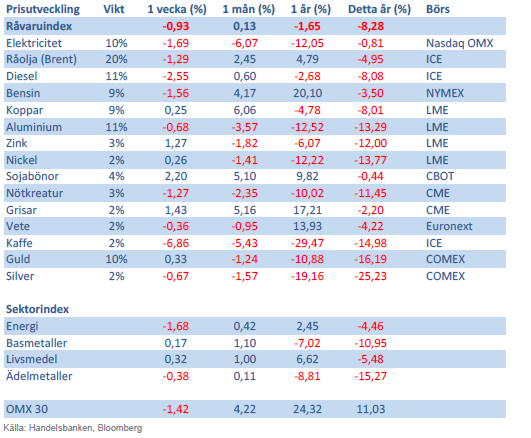
Handelsbankens råvaruindex består av de underliggande indexen för respektive råvara. Vikterna är bestämda till hälften från värdet av global produktion och till hälften från likviditeten i terminskontrakten.
[box]SHB Råvarubrevet är producerat av Handelsbanken och publiceras i samarbete och med tillstånd på Råvarumarknaden.se[/box]
Ansvarsbegränsning
Detta material är producerat av Svenska Handelsbanken AB (publ) i fortsättningen kallad Handelsbanken. De som arbetar med innehållet är inte analytiker och materialet är inte oberoende investeringsanalys. Innehållet är uteslutande avsett för kunder i Sverige. Syftet är att ge en allmän information till Handelsbankens kunder och utgör inte ett personligt investeringsråd eller en personlig rekommendation. Informationen ska inte ensamt utgöra underlag för investeringsbeslut. Kunder bör inhämta råd från sina rådgivare och basera sina investeringsbeslut utifrån egen erfarenhet.
Informationen i materialet kan ändras och också avvika från de åsikter som uttrycks i oberoende investeringsanalyser från Handelsbanken. Informationen grundar sig på allmänt tillgänglig information och är hämtad från källor som bedöms som tillförlitliga, men riktigheten kan inte garanteras och informationen kan vara ofullständig eller nedkortad. Ingen del av förslaget får reproduceras eller distribueras till någon annan person utan att Handelsbanken dessförinnan lämnat sitt skriftliga medgivande. Handelsbanken ansvarar inte för att materialet används på ett sätt som strider mot förbudet mot vidarebefordran eller offentliggörs i strid med bankens regler.
Analys
Volatile but going nowhere. Brent crude circles USD 66 as market weighs surplus vs risk

Brent crude is essentially flat on the week, but after a volatile ride. Prices started Monday near USD 65.5/bl, climbed steadily to a mid-week high of USD 67.8/bl on Wednesday evening, before falling sharply – losing about USD 2/bl during Thursday’s session.

Brent is currently trading around USD 65.8/bl, right back where it began. The volatility reflects the market’s ongoing struggle to balance growing surplus risks against persistent geopolitical uncertainty and resilient refined product margins. Thursday’s slide snapped a three-day rally and came largely in response to a string of bearish signals, most notably from the IEA’s updated short-term outlook.
The IEA now projects record global oversupply in 2026, reinforcing concerns flagged earlier by the U.S. EIA, which already sees inventories building this quarter. The forecast comes just days after OPEC+ confirmed it will continue returning idle barrels to the market in October – albeit at a slower pace of +137,000 bl/d. While modest, the move underscores a steady push to reclaim market share and adds to supply-side pressure into year-end.
Thursday’s price drop also followed geopolitical incidences: Israeli airstrikes reportedly targeted Hamas leadership in Doha, while Russian drones crossed into Polish airspace – events that initially sent crude higher as traders covered short positions.
Yet, sentiment remains broadly cautious. Strong refining margins and low inventories at key pricing hubs like Europe continue to support the downside. Chinese stockpiling of discounted Russian barrels and tightness in refined product markets – especially diesel – are also lending support.
On the demand side, the IEA revised up its 2025 global demand growth forecast by 60,000 bl/d to 740,000 bl/d YoY, while leaving 2026 unchanged at 698,000 bl/d. Interestingly, the agency also signaled that its next long-term report could show global oil demand rising through 2050.
Meanwhile, OPEC offered a contrasting view in its latest Monthly Oil Market Report, maintaining expectations for a supply deficit both this year and next, even as its members raise output. The group kept its demand growth estimates for 2025 and 2026 unchanged at 1.29 million bl/d and 1.38 million bl/d, respectively.
We continue to watch whether the bearish supply outlook will outweigh geopolitical risk, and if Brent can continue to find support above USD 65/bl – a level increasingly seen as a soft floor for OPEC+ policy.
Analys
Waiting for the surplus while we worry about Israel and Qatar

Brent crude makes some gains as Israel’s attack on Hamas in Qatar rattles markets. Brent crude spiked to a high of USD 67.38/b yesterday as Israel made a strike on Hamas in Qatar. But it wasn’t able to hold on to that level and only closed up 0.6% in the end at USD 66.39/b. This morning it is starting on the up with a gain of 0.9% at USD 67/b. Still rattled by Israel’s attack on Hamas in Qatar yesterday. Brent is getting some help on the margin this morning with Asian equities higher and copper gaining half a percent. But the dark cloud of surplus ahead is nonetheless hanging over the market with Brent trading two dollar lower than last Tuesday.

Geopolitical risk premiums in oil rarely lasts long unless actual supply disruption kicks in. While Israel’s attack on Hamas in Qatar is shocking, the geopolitical risk lifting crude oil yesterday and this morning is unlikely to last very long as such geopolitical risk premiums usually do not last long unless real disruption kicks in.
US API data yesterday indicated a US crude and product stock build last week of 3.1 mb. The US API last evening released partial US oil inventory data indicating that US crude stocks rose 1.3 mb and middle distillates rose 1.5 mb while gasoline rose 0.3 mb. In total a bit more than 3 mb increase. US crude and product stocks usually rise around 1 mb per week this time of year. So US commercial crude and product stock rose 2 mb over the past week adjusted for the seasonal norm. Official and complete data are due today at 16:30.
A 2 mb/week seasonally adj. US stock build implies a 1 – 1.4 mb/d global surplus if it is persistent. Assume that if the global oil market is running a surplus then some 20% to 30% of that surplus ends up in US commercial inventories. A 2 mb seasonally adjusted inventory build equals 286 kb/d. Divide by 0.2 to 0.3 and we get an implied global surplus of 950 kb/d to 1430 kb/d. A 2 mb/week seasonally adjusted build in US oil inventories is close to noise unless it is a persistent pattern every week.
US IEA STEO oil report: Robust surplus ahead and Brent averaging USD 51/b in 2026. The US EIA yesterday released its monthly STEO oil report. It projected a large and persistent surplus ahead. It estimates a global surplus of 2.2 m/d from September to December this year. A 2.4 mb/d surplus in Q1-26 and an average surplus for 2026 of 1.6 mb/d resulting in an average Brent crude oil price of USD 51/b next year. And that includes an assumption where OPEC crude oil production only averages 27.8 mb/d in 2026 versus 27.0 mb/d in 2024 and 28.6 mb/d in August.
Brent will feel the bear-pressure once US/OECD stocks starts visible build. In the meanwhile the oil market sits waiting for this projected surplus to materialize in US and OECD inventories. Once they visibly starts to build on a consistent basis, then Brent crude will likely quickly lose altitude. And unless some unforeseen supply disruption kicks in, it is bound to happen.
US IEA STEO September report. In total not much different than it was in January
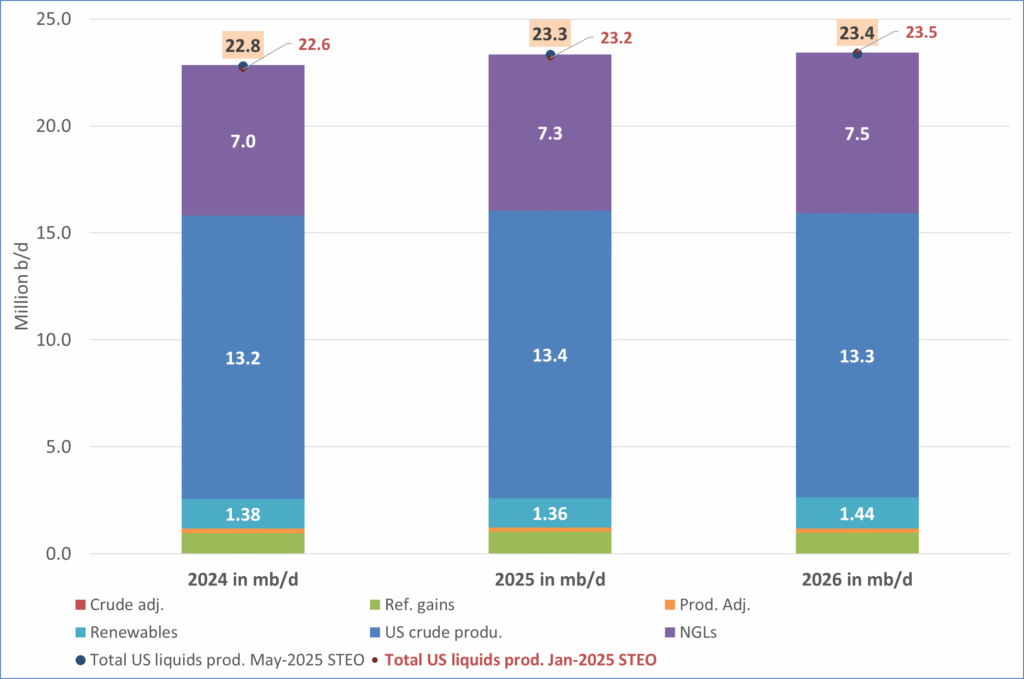
US IEA STEO September report. US crude oil production contracting in 2026, but NGLs still growing. Close to zero net liquids growth in total.
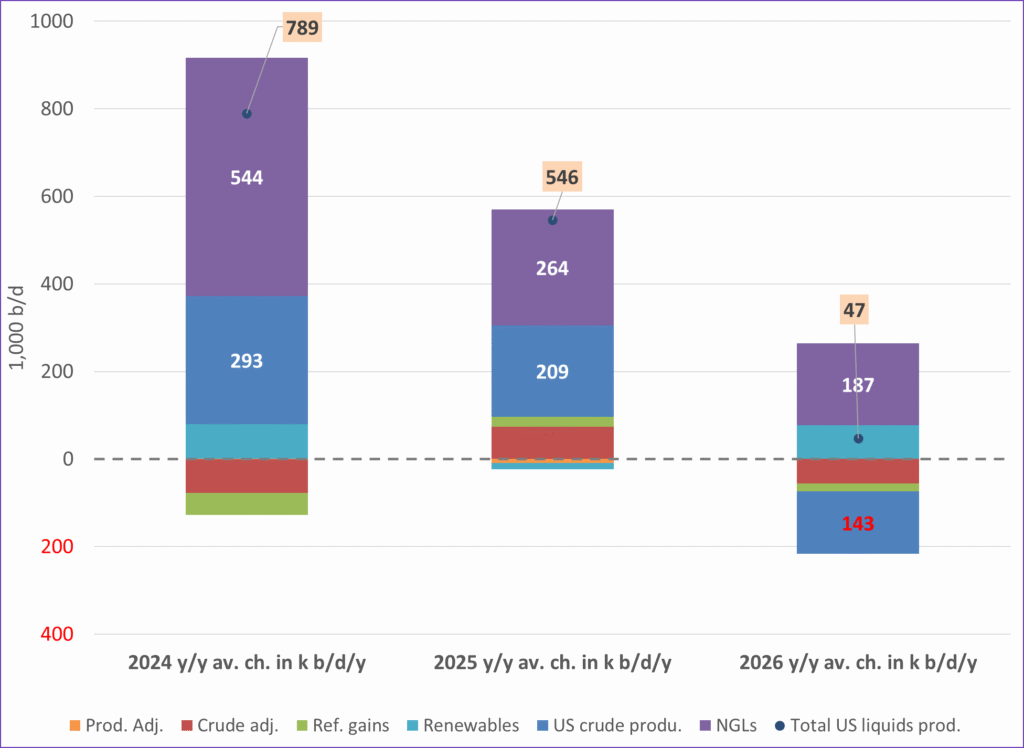
Analys
Brent crude sticks around $66 as OPEC+ begins the ’slow return’

Brent crude touched a low of USD 65.07 per barrel on Friday evening before rebounding sharply by USD 2 to USD 67.04 by mid-day Monday. The rally came despite confirmation from OPEC+ of a measured production increase starting next month. Prices have since eased slightly, down USD 0.6 to around USD 66.50 this morning, as the market evaluates the group’s policy, evolving demand signals, and rising geopolitical tension.

On Sunday, OPEC+ approved a 137,000 barrels-per-day increase in collective output beginning in October – a cautious first step in unwinding the final tranche of 1.66 million barrels per day in voluntary cuts, originally set to remain off the market through end-2026. Further adjustments will depend on ”evolving market conditions.” While the pace is modest – especially relative to prior monthly hikes – the signal is clear: OPEC+ is methodically re-entering the market with a strategic intent to reclaim lost market share, rather than defend high prices.
This shift in tone comes as Saudi Aramco also trimmed its official selling prices for Asian buyers, further reinforcing the group’s tilt toward a volume-over-price strategy. We see this as a clear message: OPEC+ intends to expand market share through steady production increases, and a lower price point – potentially below USD 65/b – may be necessary to stimulate demand and crowd out higher-cost competitors, particularly U.S. shale, where average break-evens remain around WTI USD 50/b.
Despite the policy shift, oil prices have held firm. Brent is still hovering near USD 66.50/b, supported by low U.S. and OECD inventories, where crude and product stocks remain well below seasonal norms, keeping front-month backwardation intact. Also, the low inventory levels at key pricing hubs in Europe and continued stockpiling by Chinese refiners are also lending resilience to prices. Tightness in refined product markets, especially diesel, has further underpinned this.
Geopolitical developments are also injecting a slight risk premium. Over the weekend, Russia launched its most intense air assault on Kyiv since the war began, damaging central government infrastructure. This escalation comes as the EU weighs fresh sanctions on Russian oil trade and financial institutions. Several European leaders are expected in Washington this week to coordinate on Ukraine strategy – and the prospect of tighter restrictions on Russian crude could re-emerge as a price stabilizer.
In Asia, China’s crude oil imports rose to 49.5 million tons in August, up 0.8% YoY. The rise coincides with increased Chinese interest in Russian Urals, offered at a discount during falling Indian demand. Chinese refiners appear to be capitalizing on this arbitrage while avoiding direct exposure to U.S. trade penalties.
Going forward, our attention turns to the data calendar. The EIA’s STEO is due today (Tuesday), followed by the IEA and OPEC monthly oil market reports on Thursday. With a pending supply surplus projected during the fourth quarter and into 2026, markets will dissect these updates for any changes in demand assumptions and non-OPEC supply growth. Stay tuned!
-

 Nyheter4 veckor sedan
Nyheter4 veckor sedanMeta bygger ett AI-datacenter på 5 GW och 2,25 GW gaskraftverk
-
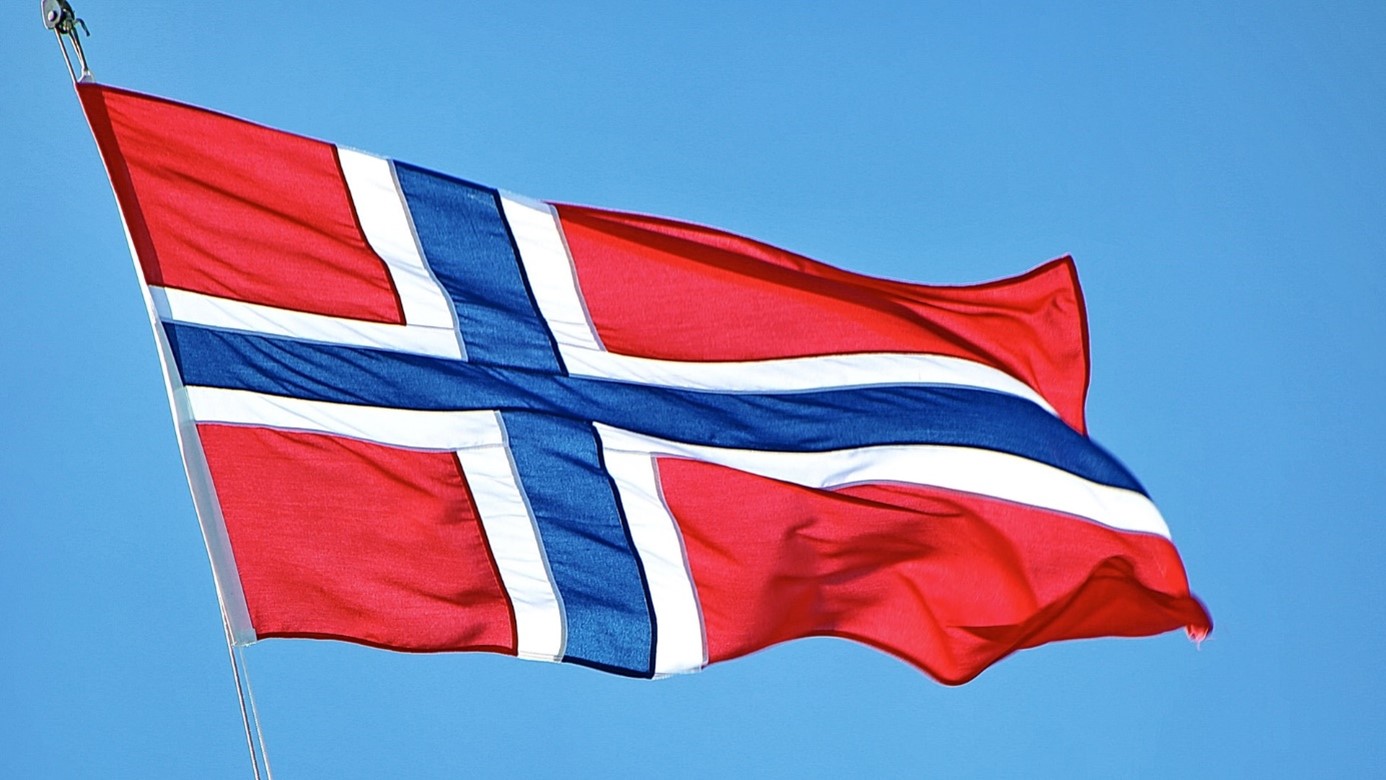
 Nyheter4 veckor sedan
Nyheter4 veckor sedanAker BP gör ett av Norges största oljefynd på ett decennium, stärker resurserna i Yggdrasilområdet
-

 Nyheter4 veckor sedan
Nyheter4 veckor sedanEtt samtal om koppar, kaffe och spannmål
-

 Analys4 veckor sedan
Analys4 veckor sedanBrent sideways on sanctions and peace talks
-

 Nyheter4 veckor sedan
Nyheter4 veckor sedanSommarens torka kan ge högre elpriser i höst
-

 Analys3 veckor sedan
Analys3 veckor sedanBrent edges higher as India–Russia oil trade draws U.S. ire and Powell takes the stage at Jackson Hole
-
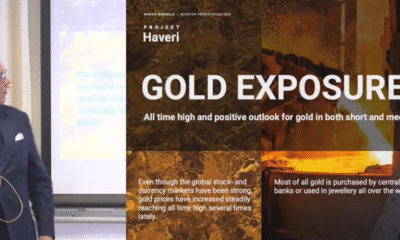
 Nyheter3 veckor sedan
Nyheter3 veckor sedanMahvie Minerals är verksamt i guldrikt område i Finland
-

 Analys3 veckor sedan
Analys3 veckor sedanIncreasing risk that OPEC+ will unwind the last 1.65 mb/d of cuts when they meet on 7 September



